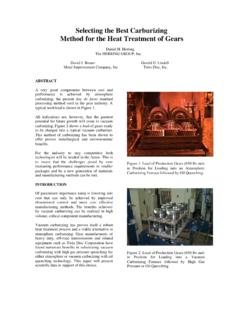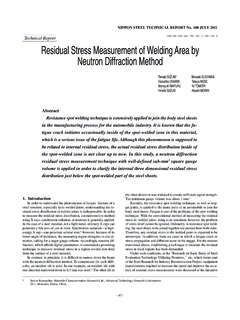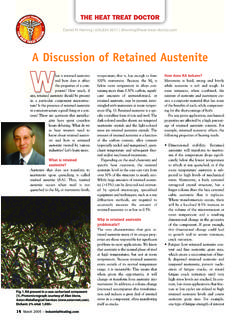Transcription of Characterization of Duplex Stainless Steel Weld …
1 207 Soldag. Insp. S o Paulo, Vol. 18, N . 03, , Jul/Set 2013 Recebido em 11/12/2012. Texto final em 05/04 of Duplex Stainless Steel Weld Metals Obtained by Hybrid Plasma-Gas Metal Arc Welding(Caracteriza o de Soldas de A o Inoxid vel Duplex Obtidas por Soldagem H brida MIG-Plasma)Koray Yurtisik1, Suha Tirkes1, Igor Dykhno2, C. Hakan Gur3, Riza Gurbuz31 Middle East Technical University, Welding Technology and Non-destructive Testing Research/Application Center, Ankara, Turkey, Laser Technologies NA, Inc.
2 , MI, United States of America, East Technical University, Department of Metallurgical and Materials Engineering, Ankara, Turkey, its high efficiency, autogenous keyhole welding is not well-accepted for Duplex Stainless steels because it causes excessive ferrite in as-welded Duplex microstructure, which leads to a degradation in toughness and corrosion properties of the material. Combining the deep penetration characteristics of plasma arc welding in keyhole mode and metal deposition capability of gas metal arc welding, hybrid plasma gas metal arc welding process has considered for providing a proper Duplex microstructure without compromising the welding efficiency.
3 Mm-thick standard Duplex Stainless Steel plates were joined in a single-pass using this novel technique. Same plates were also subjected to conventional gas metal arc and plasma arc welding processes, providing benchmarks for the investigation of the weldability of the material. In the first place, the hybrid welding process enabled us to achieve less heat input compared to gas metal arc welding. Consequently, the precipitation of secondary phases, which are known to be detrimental to the toughness and corrosion resistance of Duplex Stainless steels, was significantly suppressed in both fusion and heat affected zones.
4 Secondly, contrary to other keyhole techniques, proper cooling time and weld metal chemistry were achieved during the process, facilitating sufficient reconstructive transformation of austenite in the ferrite : Hybrid welding; Keyhole welding; Duplex Stainless Steel ; Phase balance; Secondary : Apesar da alta efici ncia da soldagem aut gena utilizando a t cnica de keyhole , a mesma n o recomendada na soldagem de a os inoxid veis Duplex devido redu o tanto da tenacidade como da resist ncia corros o de tais a os.
5 Combinando a caracter stica de alta penetra o da soldagem plasma no modo keyhole e a elevada capacidade de deposi o do processo MIG, o processo h brido MIG-plasma tem sido considerado promissor na obten o de uma microestrutura ideal sem comprometer a efici ncia da soldagem. Neste trabalho chapas de mm de espessura foram unidas utilizando esta nova t cnica. De forma comparativa, foram obtidas uni es utilizando os processos MIG e plasma convencionais. Inicialmente, foi constatado um menor aporte de calor pelo processo h brido em rela o ao processo MIG e como consequ ncia a precipita o de fases secund rias, as quais s o conhecidas por comprometer a tenacidade e resist ncia corros o, foram significativamente suprimidas tanto na solda como na zona termicamente afetada.
6 Al m disto, contrariamente a outras t cnicas utilizando keyhole foram obtidas taxa de resfriamento adequada bem como homogeneidade qu mica durante o processo permitindo a obten o de uma suficiente transforma o da austenita a partir da fase ferr : Soldagem hibrida; Soldagem keyhole ; A o inoxid vel; Equilibrio de fases; Fases secundarias. 1. IntroductionDuplex Stainless steels (DSS) have a significant competitive value among Stainless steels because of its high strength and the lower content of Ni.
7 Moreover, due to its high pitting corrosion resistance, design engineers prefer to utilize DSS rather than austenitic Stainless steels as enclosing and constructive assemblies where especially chloride attack is a significant problem. The advantageous characteristics of DSS are guaranteed by a balanced austenite ( ) / delta-ferrite ( ) distribution with minimum possible amount of secondary phases in the microstructure. Any thermal treatment above 300oC, such as fusion welding, may deteriorate the optimum microstructure of DSS [1 3].
8 The metallurgy of the as-welded DSS is principally determined by the weld metal composition and the cooling rate. Heat input, preheating and inter-pass temperatures during welding operations are major factors that affect the cooling rate. While fast cooling rates retain more of the ferrite and lead to a 208 Soldag. Insp. S o Paulo, Vol. 18, N . 03, , Jul/Set 2013 Koray Yurtisik, Suha Tirkes, Igor Dykhno, C. Hakan Gur, Riza Gurbuzhigher probability of precipitation of nitrides [4, 5], slow cooling rates and prolonged welding durations increase the possibility of spinodal decomposition of Cr-rich-ferrite ( ), namely 475oC-embrittlement, and precipitation of intermetallics, such as Sigma ( ) and Chi ( ) [6].
9 Therefore heat input has to be in tight upper and lower limits and inter-pass temperatures are kept relatively low (180 200oC) during conventional multi-pass fusion welding in order to obtain moderate cooling rates [1, 7]. Controlling such low-tolerance welding parameters brings extra engineering and fabrication man-hours during conventional multi-pass welding processes. As long as the solidified microstructure is controlled, welding of DSS in a single pass would provide both welding economy and consistency in metallurgical and mechanical quality.
10 Single-pass weldments of DSS can be obtained by plasma arc welding (PAW), Laser beam welding (LBW), hybrid Laser arc welding (HLAW) and electron beam welding (EBW) in keyhole mode. However, these welding techniques are applicable to joints that have very narrow gap or no gap, therefore it is not possible to introduce proper amount of filler metal, which has excess Ni, to the weld metal to obtain enough in matrix. Beside their very low heat inputs [8, 9], autogenous or partly-autogenous keyhole welding may lead to an excess -ferrite forming in as-welded DSS that leads to deterioration of the toughness and the corrosion properties of the material [10, 11].















